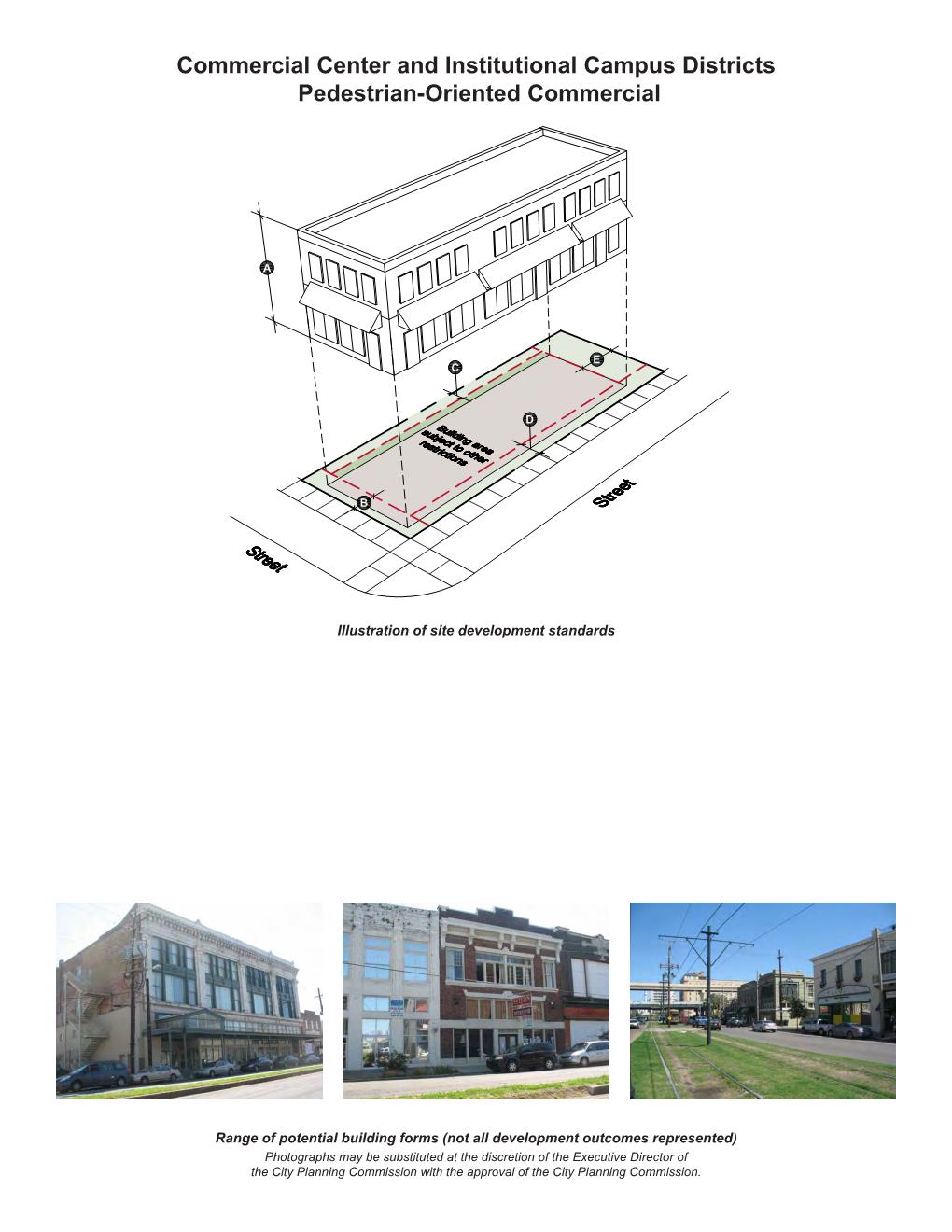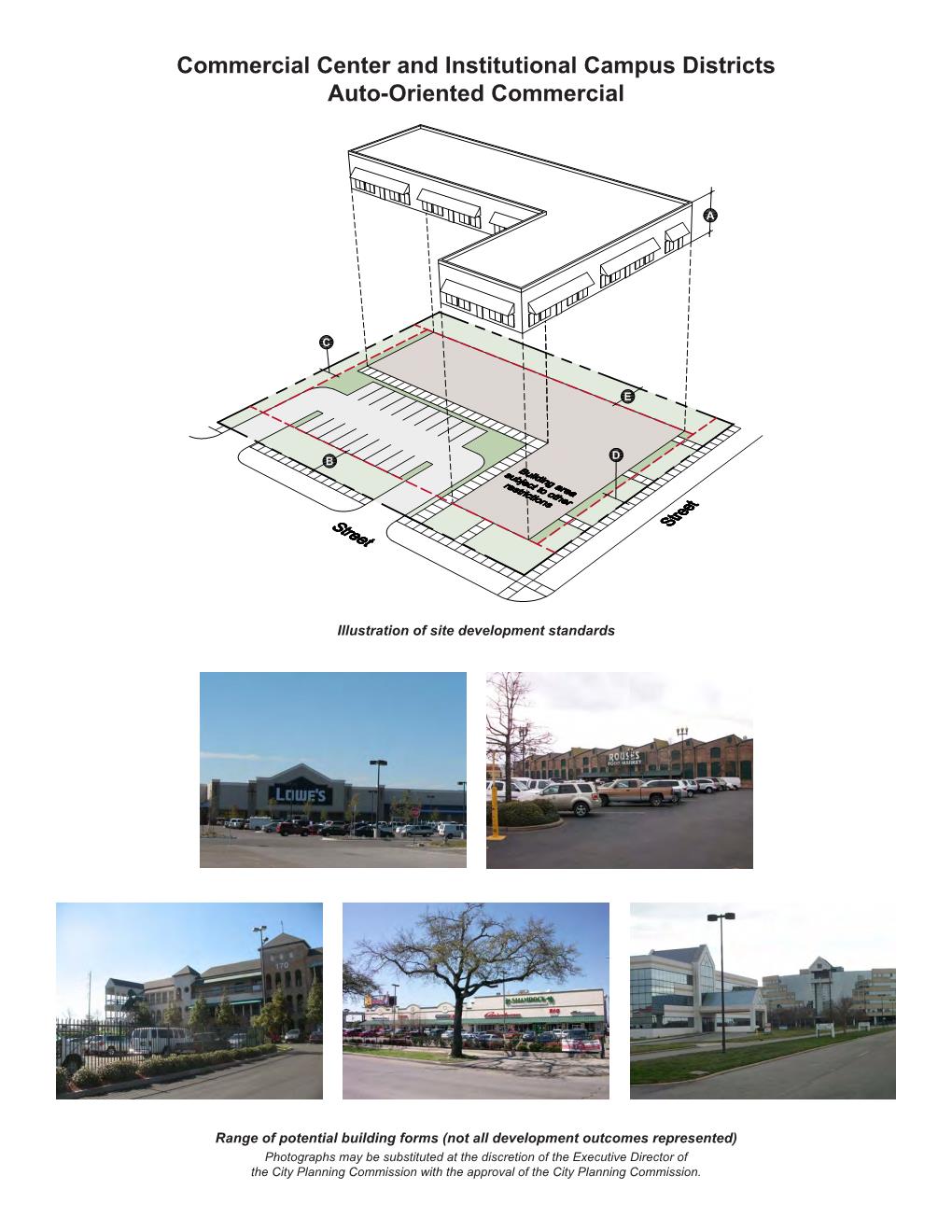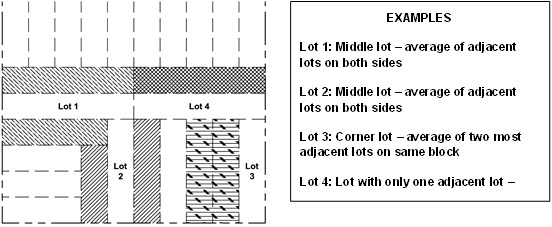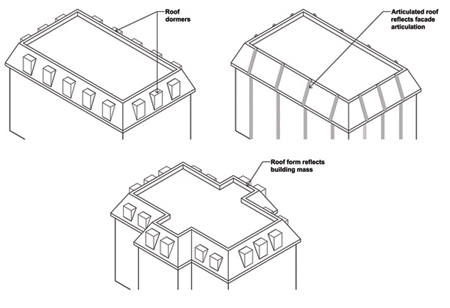New Orleans Comprehensive Zoning Ordinance
Printed: 4/19/2024 5:50:02 PM
15.3 Site Design Standards
15.3.A Bulk and Yard Regulations
15.3.A.1 General Regulations
Table 15-2: Bulk and Yard Regulations establishes bulk and yard regulations for the Commercial Center and Institutional Campus Districts.
Table 15-2: Bulk & Yard Regulations
| Table 15-2: Bulk & Yard Regulations |
|
BULK & YARD REGULATIONS1
|
C-1
|
C-2
|
C-3
|
MU-1
|
MU-2
|
EC
|
MC
|
MS
|
LS
|
|
BULK REGULATIONS
|
|
|
MINIMUM LOT AREA
|
Dwelling, Above the Ground Floor: 1,000sf/du
Non-Residential: 3,000sf
|
Dwelling, Above the Ground Floor: 1,000sf/du
Non-Residential 5,000sf
|
Dwelling, Above the Ground Floor: 800sf/du
Non Residential: 5,000sf
|
SF: 3,000sf/du
2F: 1,700sf/du
MF: 1,000sf/du
Small MF Affordable: None
Townhouse: 2,000sf/du
Non-Residential: None
|
SF: 3,000sf/du
2F: 1,700sf/du
MF: 800sf/du
Small MF Affordable: None
Townhouse: 1,800sf/du
Non-Residential: None
|
SF & 2F: Equal to that of the most restrictive adjacent residential district. All other uses: 2 acres
|
SF & 2F: Equal to that of the most restrictive adjacent residential district. All other uses: 2 acres.
|
None
|
5,000sf
|
|
A
|
MAXIMUM BUILDING HEIGHT
|
40’ & no more than 3 stories
|
40’ & no more than 3 stories
|
130’ & no more than 12 stories
|
SF & 2F: 35’
Townhouse: 40’ & no more than 3 stories
MF & Non-Residential: 60’ & no more than 5 stories
|
SF & 2F: 35’
Townhouse: 40’ & no more than 3 stories
MF & Non-Residential: 85’ & no more than 7 stories
|
Limited to 2 times the most restrictive height of adjacent districts; height may be increased by 1’ for each additional foot of setback from the required yard; additional height may be obtained through the conditional use process
|
Limited to 2 times the most restrictive height of adjacent districts; height may be increased by 1’ for each additional foot of setback from the required yard
|
When adjacent to residential district: Maximum height of adjacent residential district - may exceed this height by 20 ft when the structure is set back 3’ from residential district line for each additional 5’ in building height
When adjacent to non-residential district: 100’
|
100’, unless adjacent to a residential district then 50’ but may exceed 50’ if set back 1’ for each foot above 50’ up to 100’
|
| |
MINIMUM PERMEABLE OPEN SPACE |
20% of the lot area |
20% of the lot area |
20% of the lot area |
20% of the lot area |
20% of the lot area |
30% of the lot area |
30% of the lot area |
30% of the lot area |
30% of the lot area |
|
MINIMUM YARD REQUIREMENTS
|
|
B
|
FRONT YARD
|
Section 15.3.A.2
|
Section 15.3.A.2
|
Section 15.3.A.2
|
Section 15.3.A.2
|
Section 15.3.A.2
|
SF & 2F: Equal to that of the most restrictive adjacent residential district. All other uses: 10’
|
SF and 2F: Equal to that of the most restrictive adjacent residential district. All other uses: 10’
|
20’
|
Section 15.3.A.2
|
| C |
INTERIOR SIDE YARD |
None, unless abutting a residential district then 5' |
5' |
10' |
SF & 2F: 10% of lot width or 3’, whichever is greater
Townhouse: 10’
MF & Non-Residential/Mixed-Use: None, unless abutting a residential district then 5’ |
SF & 2F: 10% of lot width or 3’, whichever is greater
Townhouse: 10’
MF & Non-Residential/Mixed Use: None, unless abutting a residential district then 5’ |
SF & 2F: Equal to that of the most restrictive adjacent residential district. All other uses: 10’, unless abutting residential district then 25’ |
SF and 2F: Equal to that of the most restrictive adjacent residential district. All other uses: 10’, unless abutting residential district then 25’ |
10' |
None, unless abutting residential district then 10’ |
| D |
CORNER SIDE YARD |
None |
10' |
10' |
None |
None |
SF & 2F: Equal to that of the most restrictive adjacent residential district. All other uses: 10' |
SF & 2F: Equal to that of the most restrictive adjacent residential district. All other uses: 10' |
10' |
None to a maximum of 20' |
| E |
REAR YARD |
None, unless abutting a residential district then 20’ |
25' |
25' |
Residential: 20’
Non-Residential/Mixed-Use: None, unless abutting a residential district then 20’ |
Residential: 20’
Non-Residential/Mixed-Use: None, unless abutting a residential district then 20’ |
SF & 2F: Equal to that of the most restrictive adjacent residential district. All other uses: 20’, unless abutting residential district then 35’ |
SF & 2F: Equal to that of the most restrictive adjacent residential district. All other uses: 20’, unless abutting residential district then 35’ |
10' |
10’, unless abutting residential district then 20’ |
TABLE 15-2 FOOTNOTES
1 If a property abuts more than one zoning district, the more restrictive yard requirement applies.
Table 15-3: The Mandatory Inclusionary Zoning Sub-District (MIZ) regulations establish mandatory inclusionary unit thresholds, set aside requirements, and Area Medium Income (AMI) levels and is required for any development that contains residential development of 10 or more dwelling units, including rental and homeownership dwelling units. Affordable Housing Units shall be in accordance with the standards outlined in the table below. All other bulk and yard regulations for the sub-districts are subject to the corresponding non-inclusionary zoning base district regulations.
|
Table 15-3: Commercial Center & Institutional Campus Inclusionary Zoning
Sub-District Regulations1
|
|
Zoning Sub-District
|
Minimum Lot Area Requirement
|
Affordable Housing Unit Threshold
|
Set Aside Requirement %
|
Area Medium Income (AMI) Rental Units (%)
|
Area Medium Income AMI Homeownership (%)
|
|
C-1-IZ
|
NA2
|
10
|
5
|
60
|
60
|
|
C-2-IZ
|
NA2
|
10
|
5
|
60
|
60
|
|
C-3-IZ
|
NA2
|
10
|
5
|
60
|
60
|
|
MU-1-IZ
|
1,000 sf/du
|
10
|
5
|
60
|
60
|
|
MU-2-IZ
|
800 sf/du
|
10
|
5
|
60
|
80
|
TABLE 15-3 FOOTNOTES
1The terms for the Mandatory Inclusionary Zoning Sub-Districts in this section are outlined in Article 28.
2The minimum lot area requirements for properties in these districts are non-applicable. Multi-family development is only permitted above the ground floor and developments are subject to the development standards in Table 14-2: Bulk and Yard Regulations.
.


Adopted by Ord. No. 27,722, §8, April 11, 2018, Zoning Docket 113/17; Ord No. 027883, §1, October 10, 2018, Zoning Docket 079/18; Ord. 28036 MCS, Sec. 1, March 28, 2019, ZD 112/18; Ord. No. 28,911, §7, January 6, 2022, Zoning Docket 084/21
15.3.A.2 Front Yard Build-To Line Requirement
a. Within the C-1, C-2, C-3, MU-1, MU-2 and LS Districts of the Commercial Center and Institutional Campus Districts, the front yard build-to line is established by any one (1) of the following methods. A build-to line is an established setback line at which a structure is required to build. However, in no case may the front yard exceed twenty (20) feet.
i. As of the effective date of this Ordinance, the current front yard of the existing structure may be set as the required front yard build-to line. When a structure is demolished, the demolition permit shall indicate the dimension of the front yard prior to demolition. The required front yard build-to line is that indicated on the demolition permit.
ii. The required front yard build-to line indicated on the most recent survey or Sanborn maps.
iii. The average of the front yard of the adjacent lots on either side may be used to establish the required front yard build-to line. Averaging is based on the two (2) adjacent lots or, in the case of a corner lot, two (2) neighboring lots on the same blockface. In the case of a lot configuration where only one (1) lot is available for averaging, the front yard build-to line is that of the adjacent lot. (See Figure 15-1: Front Yard Averaging)
b. The applicant is permitted a three (3) foot variation from a front yard build-to line established by any of the above methods.
c. The required front yard build-to line is measured as the narrowest dimension from the front lot line to the principal structure. The measurement is taken from the building walls of the principal structure and does not include permitted encroachments or architectural features.
d. Should the calculation of the required front yard setback be unable to be determined by the methods identified in item a above, the Director of the Department of Safety and Permits shall determine the setback based on his/her judgement given the development pattern in the immediate surrounding area.
FIGURE 15-1: FRONT YARD AVERAGING

15.3.B Building Design Standards
1. The following building design standards apply to development within the C-1, C-2, C-3, MU-1, MU-2, and LS Districts, with the exception of single and two family residential uses.
a. The primary entrances shall be oriented to the primary street.
b. The ground floor of newly constructed commercial buildings shall contain a minimum transparency of fifty percent (50%) on the primary street and windows shall be constructed of transparent glass. Opaque, highly tinted, or reflective glass is prohibited. Transparency into the building shall be maintained. Any window signs shall consist of individual letters and numerals without the use of any background.
c. Security bars, if installed, shall be on the inside of windows. Roll-up or accordion security grilles are permitted on the ground floor when constructed of a see-through, non-solid material. The Casing shall be painted to match the building and shall not damage or obscure architectural detailing.
d. Plain mansard roofs are prohibited. Decorative mansard roofs are permitted on buildings with a minimum wall height of two (2) stories. (See Figure 15-2: Examples of Decorative Mansard Roofs).
e. Decorative elements having historically functional purposes, such as shutters, balconies, windows, and doors, shall be operational.
f. Any structure designed for a ground floor non-residential use shall be designed with a minimum ceiling height of twelve (12) feet, except for parking areas.
g. Loading areas for retail anchor stores of twelve thousand (12,000) square feet in gross floor area or more are required to be located in the rear.
h. Outlot buildings shall be designed with showcase windows and entrances oriented to the street.
i. Secondary access points are encouraged from rear parking lots. Facades that abut parking areas and contain a public entrance shall include pedestrian walkways.
j. When a shopping center is located behind a parking lot, a street presence for the shopping center shall be created by locating part of the center and/or outlot buildings near the lot line at the primary street corner or the shopping center entrance. When the center’s frontage on the primary street exceeds two-hundred fifty (250) feet in width, part of the center and/or outlot buildings shall hold at least fifty percent (50%) of the front lot line. (See Figure 15-3: Building Siting).
k. The following building materials are prohibited on exterior elevations visible from the public right-of-way. However, such materials may be used as part of decorative or detail elements, or as part of the exterior construction that is not used as a surface finish material.
1. Exterior insulating finish systems (EIFS)
2. Stuccato Board
3. Vinyl
FIGURE 15-2: EXAMPLES OF DECORATIVE MANSARD ROOFS

FIGURE 15-3: BUILDING SITING

2. The following standards shall apply to all sites that meet the applicability thresholds of Section 4.5 Development Plan and Design Review:
a. A cohesive shopping center character is required through the use of coordinated hardscape treatment, such as special paving materials, lighting, and street furniture, coordinated signs and landscape. Pedestrian areas shall include shade trees and seating areas.
b. Public entrances shall be articulated from the structure mass.
c. Shopping centers with frontage on the primary street that exceeds two-hundred fifty (250) feet in width and a lot depth of three-hundred (300) feet or more are encouraged to construct an access road with parallel parking along that primary street. If an access road is constructed, retail storefronts shall be oriented to this access road.
d. Structures shall use decorative roof elements, such as projecting cornices, to define public entrances, main pedestrian routes or activity areas.
e. When visible from the public right-of-way (excluding alleys), façades shall include architectural features to avoid the appearance of blank walls facing the street. These include, but are not limited to, changes in the wall plane of at least six (6) inches, changes in wall texture or masonry patterns, colonnade, columns, or pilasters.
f. Windows along the street shall be set back into or projected out from the façade to provide depth and shadow.
g. Green roof, blue roof, and white roof designs are encouraged.
Adopted by Ord. 29126, 8-12-22, ZD016/22